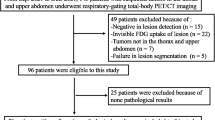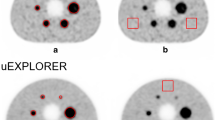Abstract
Purpose
If the CT scan of a combined PET/CT study is performed as a full diagnostic quality CT scan including intravenous (IV) contrast agent, the quality of the joint PET/CT procedure is improved and a separate diagnostic CT scan can be avoided. CT with IV contrast can be used for PET attenuation correction, but this may result in a bias in the attenuation factors. The clinical significance of this bias has not been established. Our aim was to perform a prospective clinical study where each patient had CT performed with and without IV contrast agent to establish whether PET/CT with IV contrast can be used for PET attenuation without reducing the clinical value of the PET scan.
Methods
A uniform phantom study was used to document that the PET acquisition itself is not significantly influenced by the presence of IV contrast medium. Then, 19 patients referred to PET/CT with IV contrast underwent CT scans without, and then with contrast agent, followed by an 18F-fluorodeoxyglucose whole-body PET scan. The CT examinations were performed with identical parameters on a GE Discovery LS scanner. The PET data were reconstructed with attenuation correction based on the two CT data sets. A global comparison of standard uptake value (SUV) was performed, and SUVs in tumour, in non-tumour tissue and in the subclavian vein were calculated. Clinical evaluation of the number and location of lesions on all PET/CT scans was performed twice, blinded and in a different random order, by two independent nuclear medicine specialists.
Results
In all patients, the measured global SUV of PET images based on CT with IV contrast agent was higher than the global activity using non-contrast correction. The overall increase in the mean SUV (for two different conversion tables tested) was 4.5±2.3% and 1.6±0.5%, respectively. In 11/19 patients, focal uptake was identified corresponding to malignant tumours. Eight out of 11 tumours showed an increased SUVmax (2.9±3.1%) on the PET images reconstructed using IV contrast. The clinical evaluation performed by the two specialists comparing contrast and non-contrast CT attenuated PET images showed weighted kappa values of 0.92 (doctor A) and 0.82 (doctor B). No contrast-introduced artefacts were found.
Conclusion
This study demonstrates that CT scans with IV contrast agent can be used for attenuation correction of the PET data in combined modality PET/CT scanning, without changing the clinical diagnostic interpretation.

Similar content being viewed by others
References
Wahl RL. Principles and practice of positron emission tomography. Philadelphia, PA: Lippincott Williams & Wilkins; 2002
Lardinois D, Weder W, Hany TF, Kamel EM, Korom S, Seifert B, et al. Staging of non-small-cell lung cancer with integrated positron-emission tomography and computed tomography. N Engl J Med 2003;348:2500–7
ACR practice guideline for the use of intravascular contrast media. Res 2002;51
Antoch G, Freudenberg LS, Beyer T, Bockisch A, Debatin J. To enhance or not to enhance? 18F-FDG and CT contrast agents in dual-modality 18F-FDG PET/CT. J Nucl Med 2004;45:56S–65S
Jessen K, Panzer W, Shrimpton P. EUR 16262. European guidelines on quality criteria for computed tomography. Luxemburg: Office for Official publications of the European Communities; 2000
Hubbell JH. Review of photon interaction cross section data in the medical and biological context. Phys Med Biol 1999;44:R1–22
Hubbell JH, Seltzer SM (2004) Tables of X-ray mass attenuation coefficients and mass energy-absorption coefficients (version 1.4). [Online] Available: http://physics.nist.gov/xaamdi [2004, November 11]. National Institute of Standards and Technology, Gaithersburg, MD. Originally published as NISTIR 5632, National Institute of Standards and Technology, Gaithersburg, MD (1995)
Holm S, Toft PA, Jensen M. Estimation of the noise contributions from blank, transmission and emission scans in PET. IEEE Trans Nucl Sci 1996;43:2285–91
von Schulthess GK. Clinical molecular anatomic imaging. Philadelphia, PA: Lippincott Williams & Wilkins; 2003
Beyer T, Antoch G, Muller S, Egelhof T, Freudenberg LS, Debatin J, et al. Acquisition protocol considerations for combined PET/CT imaging. J Nucl Med 2004;45 Suppl 1:25S–35S
Antoch G, Freudenberg LS, Stattaus J, Jentzen W, Mueller SP, Debatin JF, et al. Whole-body positron emission tomography–CT: optimized CT using oral and IV contrast materials. Am J Roentgenol 2002;179:1555–60
Kinahan PE, Townsend DW, Beyer T, Sashin D Attenuation correction for a combined PET/CT scanner. Med Phys 1998;25:2046–53
Burger C, Goerres G, Schoenes S, Buck A, Lonn AHR, Schultess GK. PET attenuation coefficients from CT images: experimental evaluation of the transformation of CT into PET 511-keV attenuation coefficients. Eur J Nucl Med Mol Imaging 2002;29:922–27
Valk PE, Bailey DL, Townsend DW, Maisey MN. Positron emission tomography. London: Springer; 2003
Antoch G, Freudenberg LS, Egelhof T, Stattaus J, Jentzen W, Debatin JF, et al. Focal tracer uptake: a potential artifact in contrast-enhanced dual-modality PET/CT scans. J Nucl Med 2002;43:1339–42
Nakamoto Y, Chin BB, Kraitchman DL, Lawler LP, Marshall LT, Wahl RL. Effects of nonionic intravenous contrast agents at PET/CT imaging: phantom and canine studies. Radiology 2003;227:817–24
Lonn AHR. Evaluation of method to minimize the effect of X-ray contrast in PET–CT attenuation correction. 2003 IEEE Nuclear Science Symposium. Conference Record IEEE Cat. No. 03CH37515 2004 Vol 3. 2220–1
Altman DG. Practical statistics for medical research. 1st ed. London: Chapman and Hall; 1999 p. 404–8
Kamel E, Hany TF, Burger C, Treyer V, Lonn AHR, von Schulthess GK, et al. CT vs 68Ge attenuation correction in a combined PET/CT system: evaluation of the effect of lowering the CT tube current. Eur J Nucl Med Mol Imaging 2002;29:346–50
Cohade C, Wahl RL. Applications of positron emission tomography/computed tomography image fusion in clinical positron emission tomography—clinical use, interpretation methods, diagnostic improvements. Semin Nucl Med 2003;33:228–37
Antoch G, Jentzen W, Freudenberg LS, Stattaus J, Mueller SP, Debatin JF, et al. Effect of oral contrast agents on computed tomography-based positron emission tomography attenuation correction in dual-modality positron emission tomography/computed tomography imageing. Invest Radiol 2003;38:784–9
Cohade C, Osman M, Nakamoto Y, Marshall LT, Links JM, Fishman EK, et al. Initial experience with oral contrast in PET/CT: phantom and clinical studies. J Nucl Med 2003;44:412–6
Keyes JW. SUV: standard uptake or silly useless value? J Nucl Med 1995;36:1836–9
Acknowledgements
We would like to thank The John & Birthe Meyer Foundation for the generous donation of the PET and cyclotron equipment, and the nuclear medicine technicians Hanne Jørgensen, Rebecca Myschetzky, Helle Jung Larsen, Susanne Svalling and Kate Pedersen and radiographer Elisabeth Abrahamsson for their helpful assistance.
Author information
Authors and Affiliations
Corresponding author
Rights and permissions
About this article
Cite this article
Berthelsen, A.K., Holm, S., Loft, A. et al. PET/CT with intravenous contrast can be used for PET attenuation correction in cancer patients. Eur J Nucl Med Mol Imaging 32, 1167–1175 (2005). https://doi.org/10.1007/s00259-005-1784-1
Received:
Accepted:
Published:
Issue Date:
DOI: https://doi.org/10.1007/s00259-005-1784-1




